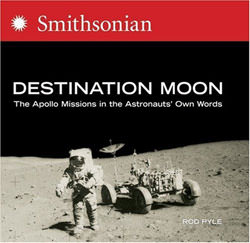
Perhaps Krafft Ehricke put it best when he said if God wanted us to be a spacefaring race, He would have given us a Moon. The Apollo Space Program validated this statement by placing astronauts on the lunar surface. Rod Pyle in his book entitled Destination Moon � The Apollo Missions in the Astronauts’ Own Words brings back those heady days when anything seemed possible, if only we had the will.
Today, with NASA’s sights reset upon our Moon, there are many people with the desire to revisit their earlier sojourns to the same locale. A generation has matured without experiencing the euphoria of proving that the Earth is round, that it orbits the Sun and that people can walk on land other than of Earth. The Apollo Space Program showed that the universe is indeed a big place and that people aren’t inherently constrained to one little planet. Using technology of the day, stronauts rocketed up to the Moon, studied the geology and drove vehicles about the surface. Twelve people stood on the surface, surveyed the landscape, poked and prodded the rocks and left foot prints. Hundreds of thousands of others helped put them there. Those times were indeed heady for humankind.
Pyle’s objective with his book is to transport the reader back to that time of breathless wonder, to enjoy and (re) experience the Apollo program as those who did firsthand. To achieve this, he uses a picture book format with a superb collection of photographs culled from thousands of original negatives. Vibrant, evocative photographs fill the pages. Square images take up the whole page, while rectangular images expand across two. Most are in colour, though many of the views of the lunar surface look black and white for obvious reasons. The clarity of each is sharp, well depicting the memorable moment, and strongly evocative of the times. With the emotion transfixed on the many displayed faces, it is very easy to return to the times of Apollo.
The book’s title is also accurate when it states that the missions are discussed in the astronauts’ own words. This is because Pyle uses the astronauts’ mission dialogue and interviews straight from NASA. These are the astronauts own words but they contain nothing original. However, the translation’s of Pete Conrad singing are particularly humorous and the chosen passages highlight the flavour of the particular mission. Throughout these dialogues, brief explanatory notes orient the reader and put the dialogue in context. In all, these provide a valuable reference when viewing the photographs.
Pyle uses a chronological format through the book. He begins with outlines of Apollo 1, 7 and 8, the preparations for flight, the testing and the experience of failure. Next he combines Apollo 9 and 10 and the success of all up testing. Then he dedicates a chapter for each of the following 7 missions. With the description of each mission, he includes the official crew pictures to remind the reader of the human element. He closes with a chapter describing Al Bean’s artwork and thoughts on spaceflight and the future. In addition to including the crew pictures for each mission, there are many spectacular photographs of the lunar surface. In the words of Buzz Aldrin, these really show the magnificent desolation of the topology. Photographs address many other times in the mission, such as pre-launch, the lunar module ascension to the command module, and, the return capsule hitting the water. With all these well chosen, striking pictures, this book makes a wonderful gift to someone who hasn’t partaken in the experience or anyone who wants to re-fresh the feelings of optimism from those days.
Walking on the Moon’s surface is possible, people have already done it! Rod Pyle in his book entitled Destination Moon � The Apollo Missions in the Astronauts’ Own Words provides dramatic evidence of this. He lets photographs do most of the talking as he returns the reader to the exciting days when people walked on the Moon. We may soon return.
Review by Mark Mortimer
